Nokia Lumia 930 Review
by Brett Howse on September 8, 2014 3:00 PM EST- Posted in
- Smartphones
- Microsoft
- Nokia
- Mobile
- windows phone
- Lumia
CPU Performance
The Lumia 930 is the second device from Nokia to utilize the Snapdragon 800 platform, with the Lumia 1520 6” Phablet also sporting the same SoC. In this particular case, it is the MSM8974VV variant which contains four Krait 400 cores at up to 2.2 GHz, along with as Adreno 330 GPU. The 930 also has 2 GB of LPDDR3 memory. This combination really kick-starts Windows Phone, which prior to the 1520 had been utilizing dual-core Krait 200 on the upper end models. The implications are dramatic, with the Lumia 930 providing a huge real-world increase in speed. Anyone who believes Windows Phone somehow does not need a faster SoC is kidding themselves, as this device has proven to me. App loading times are much quicker, and app rehydration, which is a huge issue on older devices, is so much quicker that it is almost instant. Skype is well known to all Windows Phone users for having sometimes ridiculous rehydration times, but the Snapdragon 800 almost completely overcomes this handicap.
We can use several benchmarking tools in order to quantify this difference in performance. We will start with some web based javascript tests, and then move on to some native benchmarking tools.
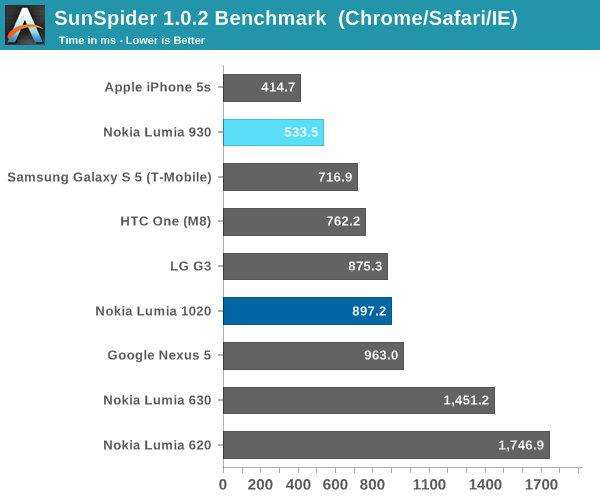
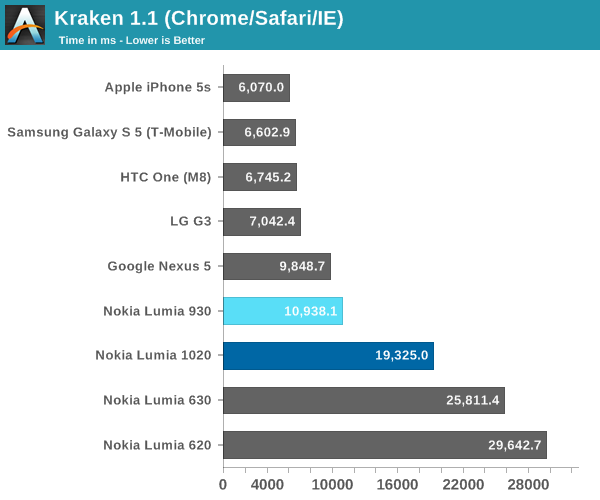
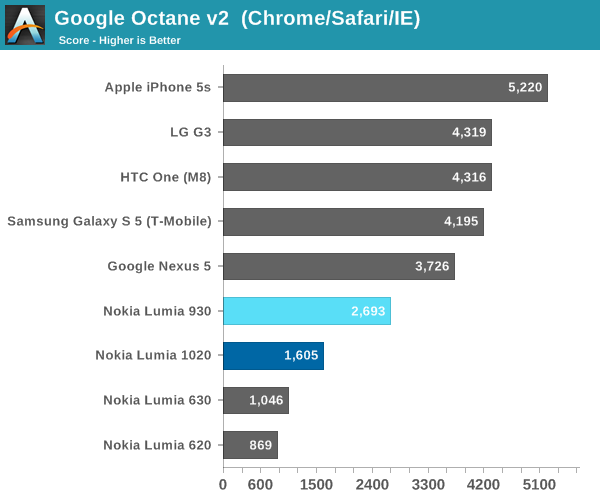
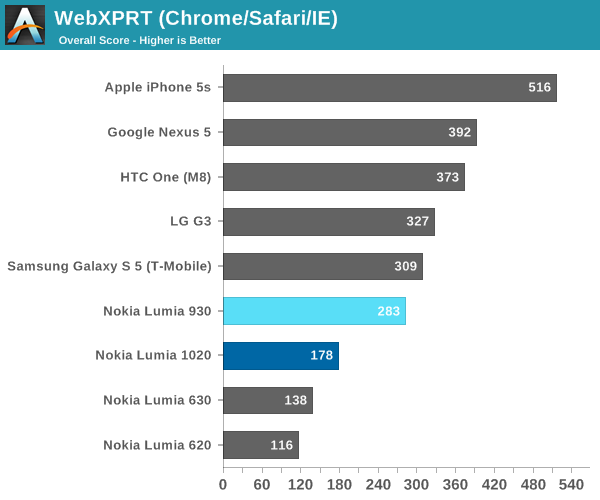
Sunspider has the Lumia 930 besting all but the iPhone 5s. Historically Internet Explorer has always done well at Sunspider though, and version 11 continues that trend. Unfortunately this benchmark has been optimized for by all companies. Moving up to more complex Javascript, we can see the difference with IE 11 compared to other browsers. The 930 falls behind the Google Nexus 5 which shares the same SoC, and it is well behind the Snapdragon 801 equipped phones. However the 930 scores almost half of the 1020 which is a great generational leap. A similar situation occurs on Google Octane, with the 930 behind the Nexus 5, but well ahead of last year’s Lumia devices. WebXPRT scores show the same trend. The Snapdragon 800 transforms Windows Phone into a contender. Javascript performance of IE 11 still is not as good as Chrome or Safari, but it is at least getting close with the latest version of the browser.
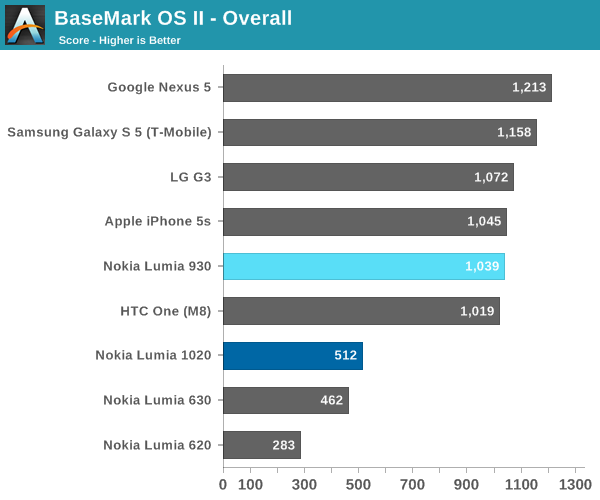
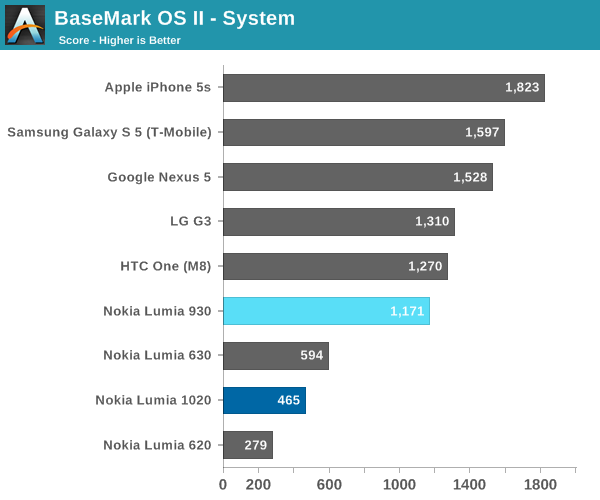
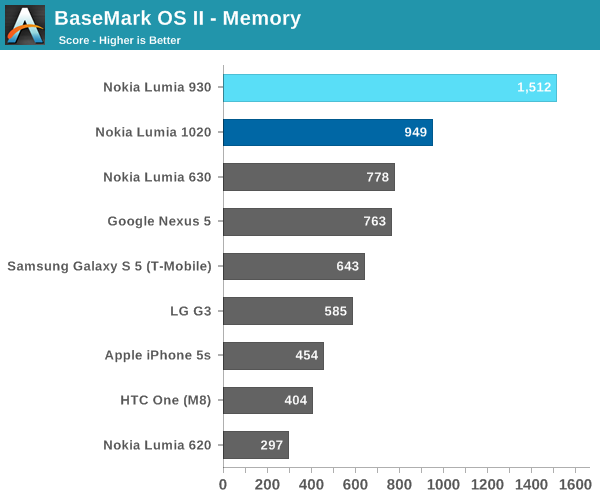
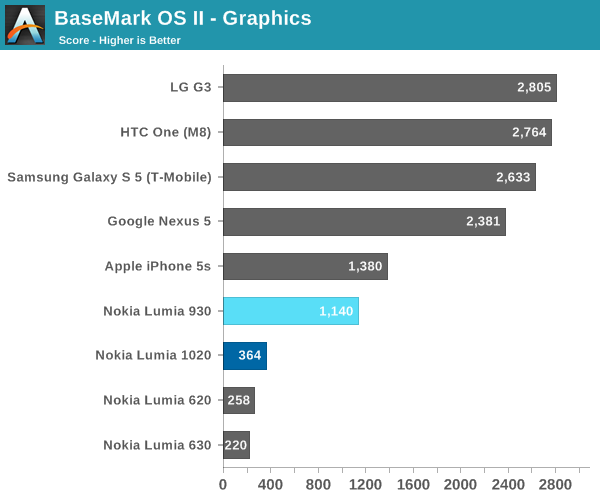
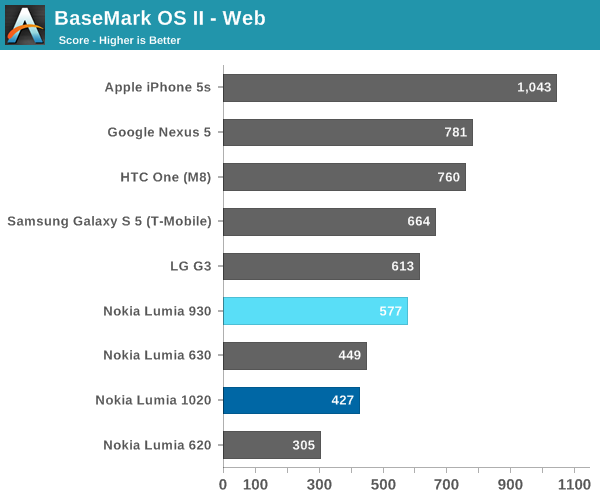
BaseMark runs as a native application, and therefore is not handicapped by the Javascript engine of the browser. Here the 930 performs well, with a score right around the same score as the iPhone 5s. Performance compared to the dual-core Krait 200 of the Lumia 1020 is once again pretty much doubled. Looking at the rest of the BaseMark scores, it becomes very clear how much of an improvement the 930 is over previous Windows Phones with MSM8960.
Graphics Performance
For GPU comparisons, we would normally turn to RightWare’s Basemark X 1.1, however a bug in the current version prevents it from running on the Lumia 1520 and Lumia 930. I have contacted them, and they have promised to look into it. If a patch is released, I will re-run the tests and update Bench. We do have access to GFXBench though, so let us see how the 930 performs.


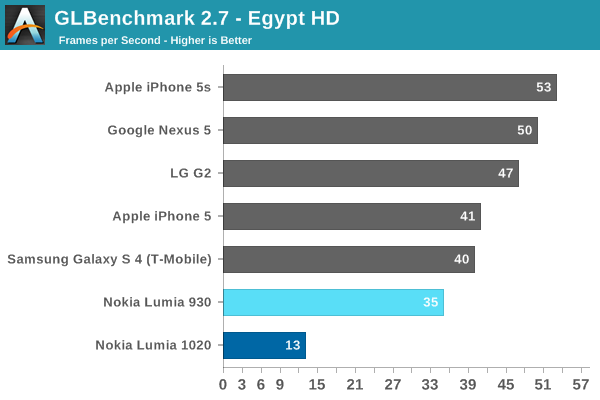
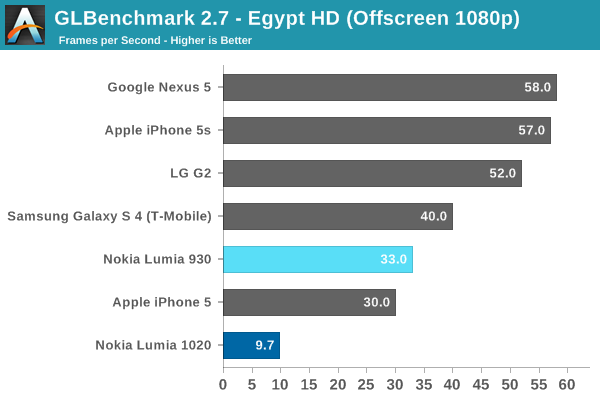
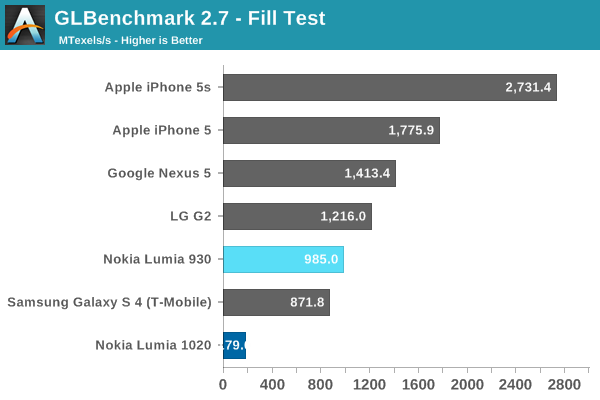
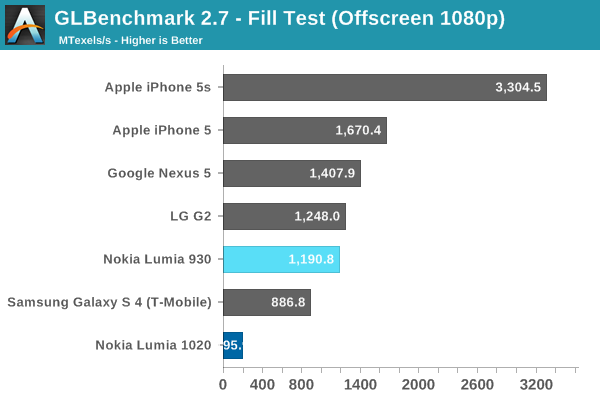


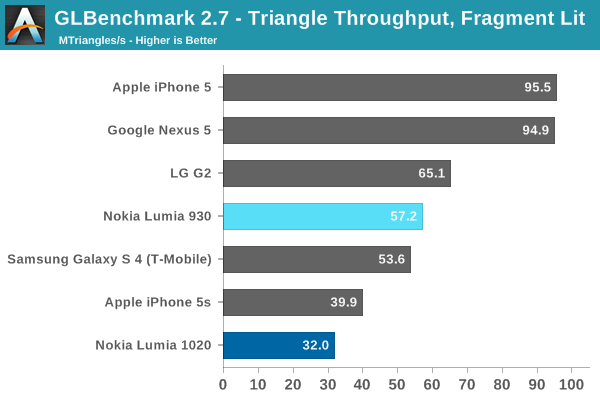
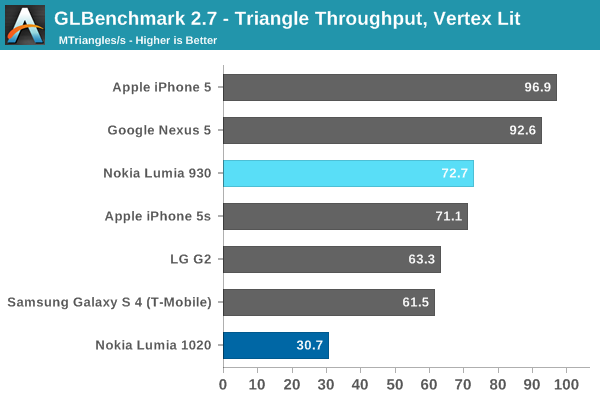

Version 2.7 of the benchmark is the current one for Windows Phone, with 3.0 listed as coming soon, however we can still get a glimpse at the huge performance leap from the last generation. While still not as quick through the benchmarks as Android and iOS, it is at least in the same room as them now.
Storage
Windows Phone does not support our storage benchmarking apps, and current ones in the store are either wildly inaccurate, or just provide abstract results. For this reason, we are going to create our own, but it is not ready yet. NAND performance was not tested on this device.
Performance Summary
One thing that Anand has harped on with regards to Windows Phone is that it is often on a much older SoC than competitive Android phones. This delta in performance is difficult to turn a blind eye to, even for supporters of the platform. With the 930 and Icon counterpart, Nokia has launched a phone which was on the most current SoC at the time of launch in February, which is a big step forward for Windows Phone performance. With the recent release of the HTC One (M8) for Windows, the platform now has the same SoC as most other flagship Android devices. That is a much bigger deal than many realize. The performance of Windows Phone has always been good on low end hardware, at least as far as the actual OS and animations, but in-app performance could suffer. The Lumia 930 is a breath of fresh air to Windows Phone and this one change alone is quite startling when compared to older devices.










115 Comments
View All Comments
Arbie - Monday, September 8, 2014 - link
SD police here...So my low-end Nokia 520 has microSD, which lets me easily swap in TV series that I watch when traveling or to kill time waiting somewhere. A new 930 at much higher price won't let me do that.
Hmmm... my love affair with Nokia (the 520 is great) will be coming to an end.
Windows Phone doesn't even have the flimsy excuses of the Android camp for no SD. It can even be read-only dumb storage, with no security issues. But no.
Not interested / will never buy it.
tuxRoller - Monday, September 8, 2014 - link
The Android issues aren't with security but, from what a Dev claimed (falsely, IMO) poor user experience.NikAwesome - Tuesday, September 9, 2014 - link
SD, mSD or whatever external storage are at least an order of magnitude slower than eMMC or ONFI or more advanced NAND interfaces. When an application like the Photo Gallery browser has to read lots of pictures from SD it is really a torture (several seconds, or tens of seconds). In the first eras of tablets and smartphones, people get accustomed that all has to launch in less than second (give or take), faster than their desktop application launch at home/work. So in this context, several seconds is inappropiately interpreted as sluggish CPU performance when the real bottleneck is in the storage IOs. These delays severely impact usability if you are used to full internal flash storage, where everything opens in under a second.I am not against mSD cards, I have an 8GB S4 mini and 32 GB mSD. I can easily tell the performance difference, but I have no choice if I want to take lots of pictures or film lost of 1080p videos.
Summing up, performance is the real reason why Google do not allow external storage on their devices (Nexus smartphones and tablets). From Apple point of view is arguable that they had contracts with music label records inheriting the iPod policy: "easy to load music into the device, a pain in the ass to extract it in order to make piracy more difficult"
jimbo2779 - Tuesday, September 9, 2014 - link
If you think sd cards make viewing photos on a phone a chore them it could be your phone or its support of SD cards that is at fault on the Lumia 620 there is no noticeable difference between photos on the phone memory and in SD card.Also there seems to be very little difference, if any, between the 620with all pics on SD and a925 with no SD support so speed is not a reason.
tobi1449 - Tuesday, September 9, 2014 - link
Plus: What's worse, photos that take a little bit longer to load or photos that either don't load at all because you don't have them with you or take much much longer and half of your free data?marcokatz - Friday, September 26, 2014 - link
Well Nokia sure is trying, but Microsoft is not exactly helping them out (they even released their own app for iPhone first... gosh). Anyway, as of today it's much better to go for one of the really good Android phones. /Marco from http://www.consumertop.com/best-phone-guide/tuxRoller - Tuesday, September 9, 2014 - link
That wasn't the reason given, iirc. The problem he mentioned was one of user removes sdcard, doesn't see his photos/apps on phone and gets confused. The other issue was technical, but, again iirc, was fixable if they wanted.jimbo2779 - Tuesday, September 9, 2014 - link
While that is the one technical issue with SD card implementation I would say there is a very small amount of people that would be able / willing to switch out the SD card and not be aware that they would be missing the contents of that SD card when they go into their photos app.When you remove a DVD from your computer do you wonder why you can't watch your favourite film anymore? Would anyone?
I am sure it has happened to someone at some point but realistically how many people would that affect compared to the amount of people that would put an extra 32 or 64 Gb in their phone and just be happy to have doubled or tripled their storage to keep a years worth of photos and videos of their kids on their phone.
Either way you look at it having the option to massively extend the amount of internal storage to have more media / apps in your phone is more favourable to most compared to having to resort to the cloud (which is just a no-go for a good portion of smartphone users across the world) or constantly removing stuff to make the newest stuff fit.
I would miss Glance but without SD card I will not be buying this which is a shame I was looking forward to it, don't even get me started on how the rumours for the 830 got me all excited and left me disappointed when the phone was finally announced. Either the 830 or 930 could have been WP halo phones for a lot of potential detractors to the WP platform, instead they are just a few tweaks short of stacking up very favourably with their android competition.
tuxRoller - Tuesday, September 9, 2014 - link
The technical issue was actually brought up by the poster below me (pjcamp). It was regarding creating a unified storage space across multiple devices.To be clear, I am NOT saying these were good reasons, I only brought them up in response to the parent who I thought MIGHT have been claiming that the reasons android dropped sd card support was related to security.
I really wish that sdcards (or some other removable storage standard) made a comeback on android.
Rama TT - Saturday, September 13, 2014 - link
"""Summing up, performance is the real reason why Google do not allow external storage on their devices "" Yeah right and it has nothing to do with Google Drive